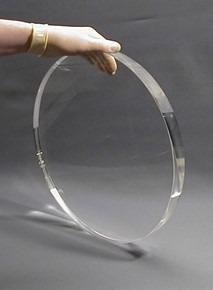i. Optical Flats

An optical flat is a piece of glass that has been precision polished to a specific flatness on one or both sides and is used as a reference (test plate) against which the flatness of an unknown surface can be compared.
Applications where Optical Surfaces optical flats are used include astronomy, laser beam steering, inspecting gauge blocks for wear and accuracy and interferometric flatness testing of prisms, filters and optical windows.
Benefiting from a unique thermally stable manufacturing environment, and working with high-stability materials such as Pyrex, fused Quartz and Zerodur, Optical Surfaces is able to routinely achieve a surface accuracy of better than lambda/10 p.v. and surface roughness of less than 1nm on reference flats up to 1000mm in diameter.
Case Study

Image Credit: Optical Surfaces Ltd.
As a part of the package for SSTL’s very high resolution, Nigerian Sat-2 Satellite system, Optical Surfaces supplied a reference flat. The purpose of this flat was to check the accuracy of the integration of the main mirrors into the payload structure. The mounted mirror had a diameter of 475 mm, was cored with a large central hole and had to have an accuracy of λ/20 PV @ 633nm. One of the requirements for the mirror performance was that it be tested laying in a horizontal configuration. This constraint necessitated the construction of a custom Fizeau interferometer that allowed correcting for gravitational forces. The satellite is operated by the Nigerian Space agency and has produced spectacular results. Following on from the success of this mission the reference flat will be used for future space projects.
ii. Optical Windows

Image Credit: Optical Surfaces Ltd.
Optical windows are typically made in the form of flat plates of a transparent medium and are often used for isolating optical systems or components against detrimental influences from the environment.
Common materials used for optical windows are fused silica and BK7 glasses for visible or near-infrared applications. For infrared applications - windows are typically made from materials including calcium fluoride, zinc selenide, silicon and germanium.
Benefiting from an ultra-stable production environment and proprietary polishing techniques – Optical Surfaces Ltd. is able to routinely produce windows up to 600mm in diameter with typical wavefront error of lambda/10 and surface finish of 40/20 to 10/5.
Case Study
Working with a range of optical materials including BK-7 and fused silica, which offer good homogeneity and transmission from the UV to the Near-IR, Optical Surfaces is today a preferred supplier of large, precision windows to many high-power laser research groups around the world.

Image Credit: Optical Surfaces Ltd.
To optimise the performance of rapid-pulsed (femtosecond) high-power lasers – Optical Surfaces Ltd is able to supply the latest dielectric coatings on windows to provide minimum pulse distortion, maximum usable bandwidth and durability.
In applications where there is significant risk of mobile material as a result of high-power laser ablation – Optical Surfaces also has considerable experience of producing large ultra-flexible windows (debris shields) to protect the final high precision lens that focuses laser energy onto the targets. Manufacturing debris shields combines the dual demands of producing a precision wavefront (typically lambda/5 to lambda/10) on a flexible window with a high diameter to thickness ratio.